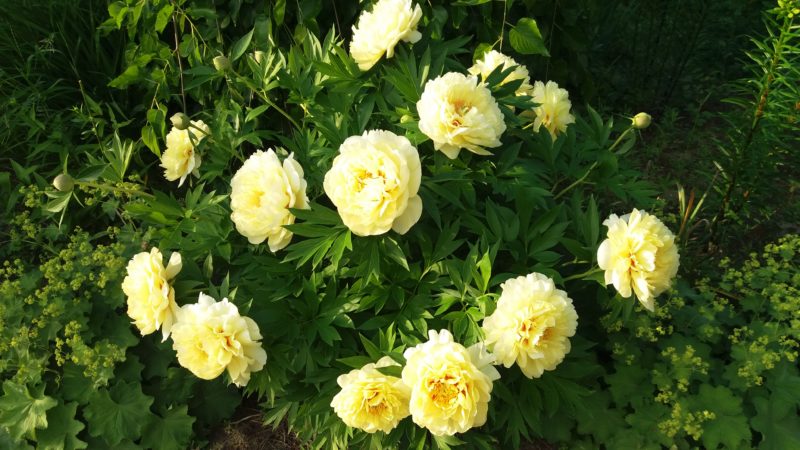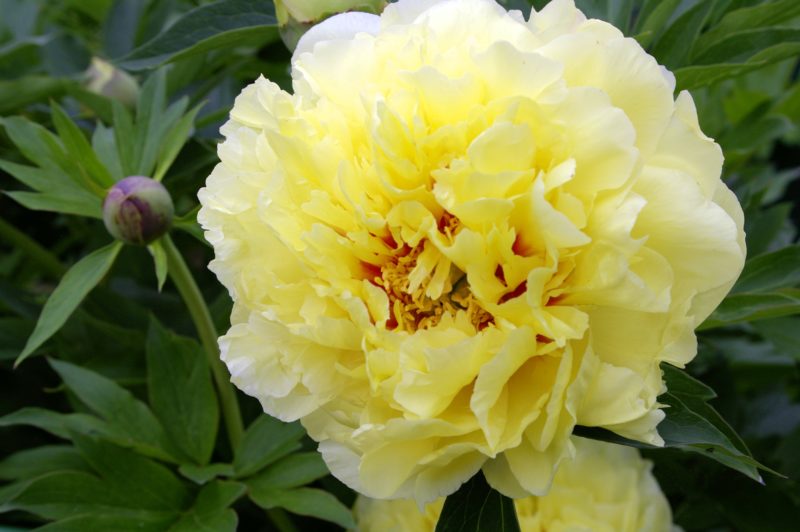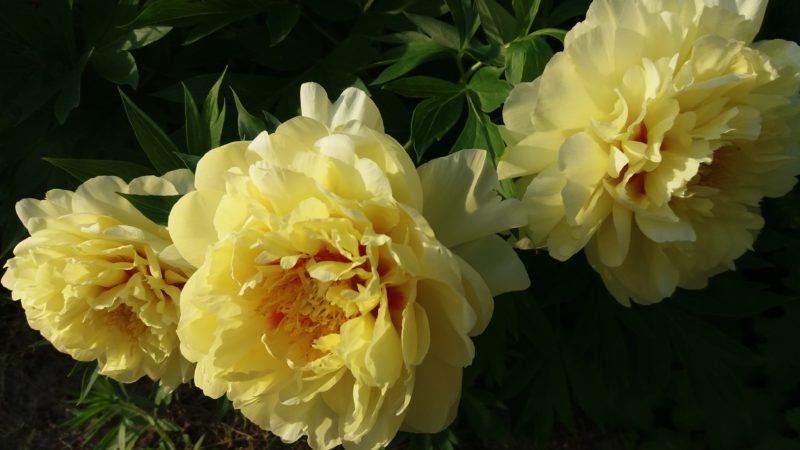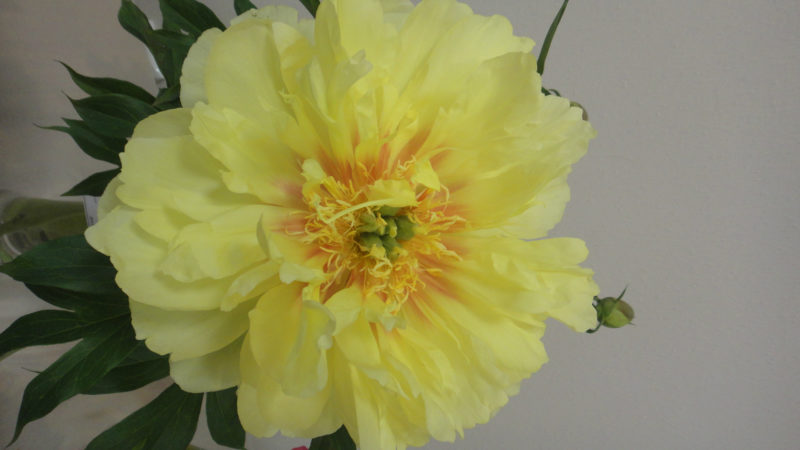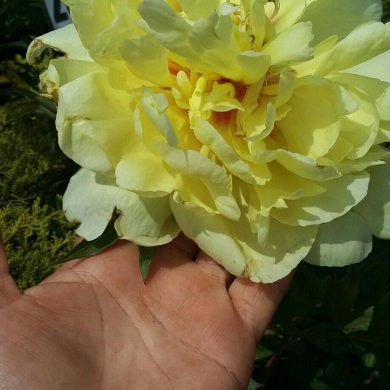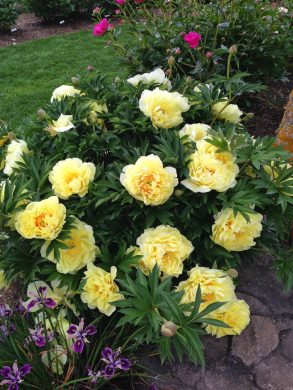A valuable gift for lovers of luxurious flowers is Bartzell's peony, combining a royal look, sophistication of color and high winter hardiness. This is the oldest variety, tested by time and difficult climatic conditions of the middle lane, including the Moscow region and the Leningrad region.
Material Content:
Peony Bartzell's Botanical Description
The Bartzella (or Bartzell) variety was obtained as a result of complex breeding work carried out by an assistant and follower of the Japanese scientist Toichi Ito, who is the founder of a new group of peonies named after him. Ito-peonies are intersectional hybrids created with the participation of dairy and tree varieties. Bartzella was introduced into the culture in 1972 and since then its popularity has not waned, despite the fact that at present there are already many other yellow-flowered Ito hybrids.
Peony Bartzella blooms on annual shoots emerging from the base of the bush, like grassy varieties. But at the same time, it retains the lower lignified part with the buds of renewal, which can successfully overwinter, provided that a combination of additional shelter and a relatively mild snowy winter. The height of the bush is up to 90 cm, in harsh conditions (Siberia, the Urals) - not higher than 50 cm.
The leaves of Ito-pions remain decorative until late autumn, as in tree varieties, acquiring a copper-red color. Peony Bartzell's flower is terry, large, pale yellow with red or dark pink strokes in the core. Flowering time - from mid-June onwards for almost a month. Bartzella has a delicate, pleasant aroma, without this specification the description of the variety would be incomplete.
Important nuances of growing
Considering the fact that Ito-peonies appeared relatively recently on the Russian market of garden plants, the price for them is much higher than for grassy and tree-like varieties. This is due to the difficulties of reproduction - from one adult bush you can get a maximum of 2 - 3 dividends, moreover, once in 3 to 4 years. But recently, meristem plants obtained in laboratory conditions have appeared on sale.
Bartzell's Ito hybrid is a peony that does not require special growing conditions, but there are still nuances.
Primary requirements:
- The most sunny location with shading at noon.
- Careful and advance preparation of the planting pit - at least 2 weeks before planting, so it is advisable to purchase seedlings in the autumn.
- Ito-peonies do not tolerate the close location of groundwater (minimum 70 cm).
Outdoor landing
A pit of 50x50x50 cm in size, having a drainage layer at the base and seasoned with a special fertile mixture - this is what any Ito-hybrid needs. Peonies of this section are demanding for a successfully prepared start.
The usual time for planting peonies is from the end of August to the end of September. Later dates are extreme for middle-band conditions.
Small stones, slate fragments, broken brick, a layer of 10-15 cm are suitable as drainage. A mixture consisting of 3 buckets of humus or high-quality compost, 0.5 buckets of wood ash, 6 tbsp. bone meal and 1 tbsp. any complex mineral fertilizer.
- The filled pit is generously shed with water and a seedling is placed in the center so that the upper bud is buried 4-7 cm from the soil surface.
- Top once again watered from a watering can to compact the soil.
- When planting in autumn, it is necessary to immediately hone the peony with dry humus or compost (do not use peat!) In the amount of 1 bucket.
- In the spring, after thawing the soil, this land must be carefully scooped up.
Flower care
Ito hybrids do not cause much trouble; they are as unpretentious in care as their brothers - grassy peonies. Timely watering until September, weeding, top dressing with complex mineral fertilizers with a low nitrogen content 2 times per season (in the first ten days of May and at the end of August) are the main stages of care for Ito varieties.
Peony Bartzella in ideal conditions can bloom repeatedly at the end of summer. To do this, after the first flowering, it is necessary to cut off the wilted inflorescences to the level of the second true leaf.
In autumn, Ito hybrids are pruned, and quite late in November, leaving the lower lignified part with the buds of renewal. The base of the bush is insulated with dry humus, spruce branches or dry leaves cut from the same plant.
Peony propagation
To preserve varietal properties, only the vegetative method of propagation is used, namely, dividing the bush. To do this, use 3 - 4-year-old specimens, the rhizomes of which have managed to grow, but are not yet lignified so that they could not be divided.
The peony bush is dug at a sufficient distance (not less than 50 cm) in order to extract it with the least damage along with the roots, which go not only to a considerable depth, but also grow in breadth. Rhizomes are divided into parts using a hacksaw or garden file so that each has 2 to 3 buds of renewal. As a result, even with powerful, well-developed plants, you can get a maximum of 3 dividends.
Diseases, pests and methods of dealing with them
Despite the fact that peonies are considered resistant to diseases and pests, plants, and sometimes difficult times come for them.
- Rust. Numerous brown or copper colored pads appearing on the leaves are a sign that spores of the fungus rust have appeared on the flower. Sick leaves are torn off and burned, and the bushes are sprayed with a solution of any copper-containing preparation.
- Powdery MildewWhitish spots on the leaves do not bring much harm to the plant, but clearly reduce their decorative qualities. It is possible to combat their distribution with the help of a 0.5% solution of soda ash with the addition of green or laundry soap. It is necessary to carry out at least 2 treatments with an interval of 7 to 10 days.
- Gray rot. Dangerous disease, especially rapidly spreading in cool rainy summers. The first sign of the disease is the withering of the young shoots of a peony in the spring, then a gray coating (mold) appears, affecting the entire aerial part of the plant. On diseased bushes, affected areas are cut out and shed with 0.6% Tiram suspension. As a prophylaxis, spring treatment with copper-containing preparations is used.
- Verticillin wilt. A dangerous disease, usually leading to the death of the plant. It is manifested by the withering of leaves and stems on an apparently healthy peony. Since the causative agent of the disease penetrates into the vascular system of the plant, the fight against it is not possible, therefore, the affected bushes are dug up with the maximum possible amount of earth and destroyed outside the site. The remaining pit is treated with bleach.
Most often on peonies you can see aphids, ants and bronzes. All of them cause harm, mainly to unopened buds and inflorescences in full dissolution. Ants will have to be disposed of with repellents scattered under the bushes, and insecticides such as Actellik, Biotlin, Aktar, Inta-Vir and others must be used to fight aphids and bronzes.
Sometimes the root system of pions is affected by colonies of gall nematodes, whose presence can be detected by swollen nodes on the rhizomes. Unfortunately, diseased bushes will have to be removed from the site to prevent further spread of the pest.
Peony Bartzell in landscape design
To emphasize the beauty and grace of the noble Ito-Pion Bartsell in the landscape design of the country garden, you will need to observe several basic rules:
- You need to choose a place very carefully, given the fact that peonies can grow on one site for many years in a row, becoming only more beautiful and stronger.
- The adult Bartzell peony looks spectacular on the lawn, being planted as a tapeworm in a single copy or as a group.
- The flowering period of Ito-hybrids is about a month, but after this, decorative foliage serves as an excellent background for flowering partners in the flower bed.
- The ideal companions for Bartzell's yellow peony during the period of the most decorative are blue, blue and purple flowers - delphiniums, veronica, aquilegia, geraniums, bells. Since mid-summer, another royal lady, the rose, has taken up the baton of abundant flowering from peony. These two plants are very often planted in the neighborhood when drawing up a landscape plan of the site.
The amazingly harmonious culture of Bartsell's peony does not leave anyone indifferent who at least once admired its flowering. Yellow Ito-hybrids will remain an object of admiration and a lust for real connoisseurs of beauty for a long time to come.


